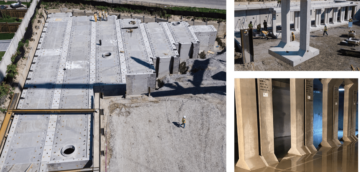What is self-compacting bedding?
Self-compacting bedding (SCB) materials, also known as self compacting soil, self-consolidating soil, or high-performing bedding in some areas, provides self-flowing, self-compacting abilities under gravity, has free draining characteristics, and restricts the penetration of fines. It is a cohesionless soil consisting of uniformly graded clean gravel or crushed stone usually with a grain size distribution of 99% retained by the 6.7mm sieve. Therefore, it is sometimes described as 6.7mm drainage stone. This material is commonly used as a bedding material for many applications but is quite often described mistakenly as “self-compacting”.
How much does self-compacting bedding compact?
Based on the tests reported by the aggregate supplier and according to ASTM C29, the loosely compacted state is between 85% and 90% of its Standard Proctor Maximum Dry Density (SPMDD), when rodded, these materials can reach 95% SPMDD. However, according to the stud (Howard, 2016), the dumped density will be about 80 percent of the maximum density because typically the density will be close to the minimum density of the soil. In the case of trench installation, the bedding materials fall into the gap and ricochet off the trench wall and pipe that substantially reduces the self compacting effort. Without further compaction, an inherent void is likely formed.
Related: Benefits of Precast Box Standards
Why bedding materials are important for RCP
In the design of reinforced concrete pipe (RCP), the structural capacity is determined using a destructive (three-edge bearing) test according to CSA A257 to determine the crack load and ultimate load. The result (class of pipe) is normalized to the force (Newton per meter long per millimeter internal diameter) that the pipe can withstand without exceeding the 0.3mm crack limit. The class of the pipe needs to be greater than the field loads due to the overburden soil and live load divided by the bedding factor. The bedding factor is based on the soil type and compaction effort in the specified installation type. Granular materials with a high level of compaction will have a higher bedding factor. In Ontario, Class B and Class C bedding has a bedding factor of 1.9 and 1.5 respectively. It is important to respect the calculated pipe class and specified installation type when executing the installation.
How does the use of self-compacting beddings impact the performance of RCP?
Many contractors substitute the specified Class B bedding with self compacting material with minimal or no compaction effort in an attempt to speed up the installation as it is believed that SCB provides a higher level of performance than conventional bedding materials. This could lead to the previously detailed inherent voids at the lower haunches of the installed RCP. Despite more scientific research being needed to determine the bedding factor, the bedding quality has been claimed to be equivalent to Class C bedding (Dufferin, 1993). Figure 3 shows the difference in the applied load for 2400mm RCP buried under embankment conditions. With the earth depth deeper than 1.2m, the load experienced by the RCP using class C bedding is about 20% more than that of Class B bedding. In other words, when SCB is used, the pipe will need an additional 20% capacity (higher class) to withstand the field loads.
Conclusive remarks
Self-compacting bedding does not offer better performance for RCP installations. The SCB material can be assumed to be a Class C bedding but some pipe designs may require a higher class of concrete pipe to be supplied when the Class B bedding is specified. Compaction is still required when using SCB’s. Contractors are advised that they should obtain approval from the design engineer and the pipe supplier if a substitution of the bedding material is being contemplated. It is also recommended that the use of standard materials for RCP installations are in accordance with Class A, Class B or Class C from the Ontario Provincial Standards (OPS) or Standard Installation Types 1, 2, 3, and 4 from the Canadian Highway Bridge Design Code (CSA S6). Design engineers should specify the pipe class accordingly. These standard installation types have specific requirements on the soil types and the compaction effort which must be achieved during the installation process.
References
ASTM C29, Bulk Density “Unit Weight” and Voids in Aggregate (Loose and Rodded) Howard, Amster (2016) ‘Self-compacting’ soil, Underground Construction, February 2016, Vol 71 No. 2. Dufferin Aggregate (1993) High Performance Bedding C-2 Pipe Bedding – Wasteless Construction.
By: Lui Sammy Wong, P.Eng., M.E.Sc.

IntroductionPrecast concrete has been widely used in constructing infrastructure for decades. Its ability to accelerate ...

The Greater Toronto Area (GTA), which includes the City of Toronto, Regions of Peel, Halton, ...

The Canadian Concrete Pipe & Precast Association (CCPPA) was established in 2013 to represent concrete ...
